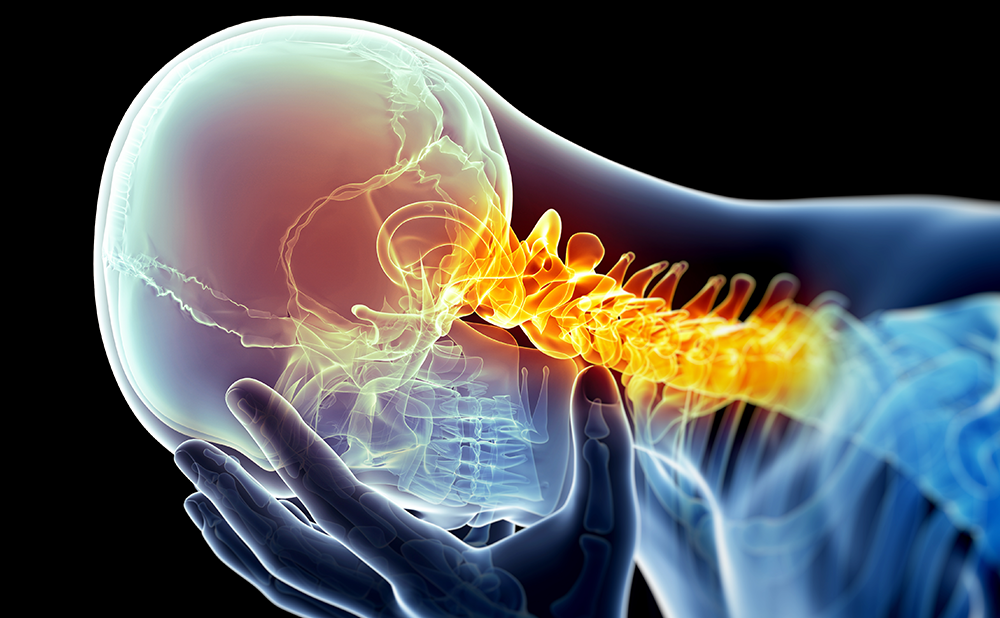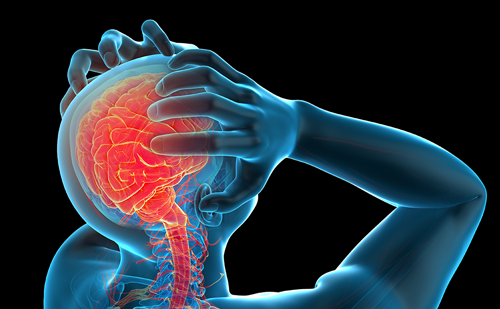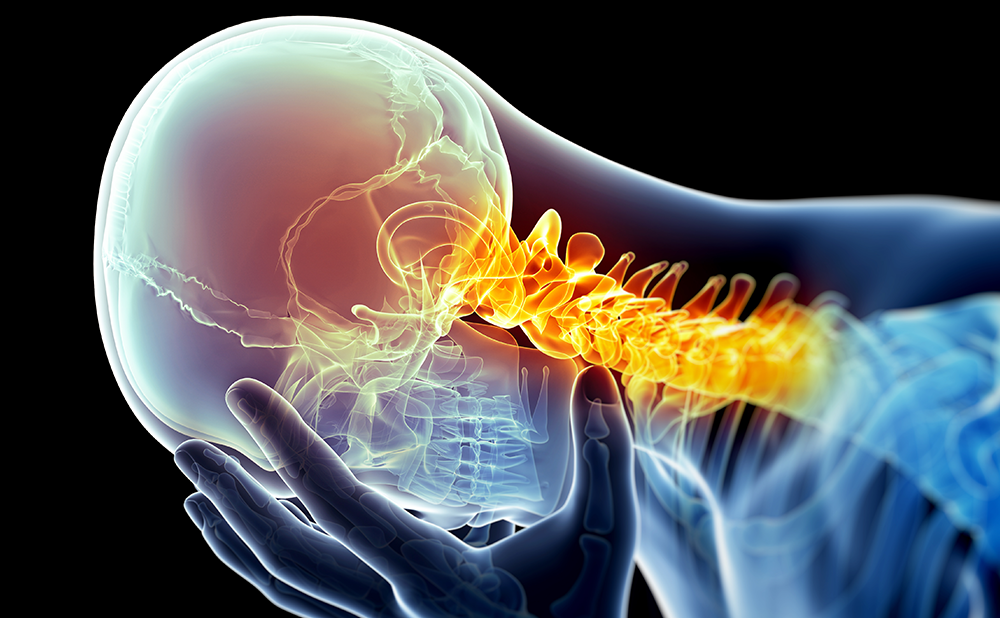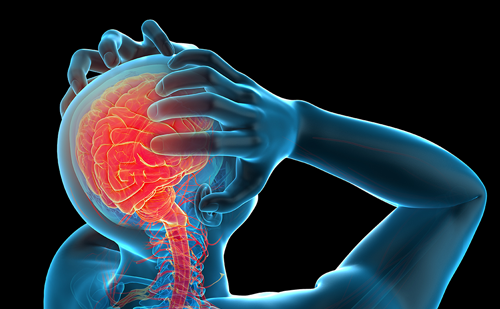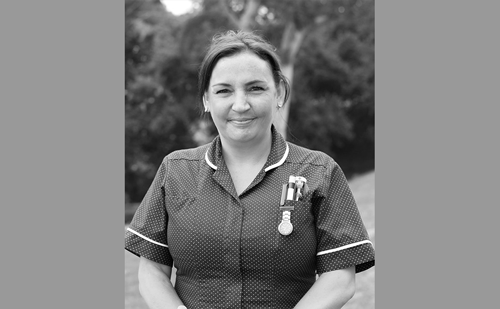Trigeminal autonomic cephalgias (TACs) are rare, short-lasting, disabling primary headaches. They comprise cluster headache, paroxysmal hemicrania and short-lasting unilateral neuralgiform headache attacks with conjunctival injection and tearing (SUNCT). Over the last decade, neuroimaging findings in TACs have supported the hypothesis that activation of posterior hypothalamic neurons plays a pivotal role in TAC pathophysiology, and have prompted the idea that hypothalamic stimulation may inhibit this activation to improve or eliminate the pain in intractable chronic cluster headache and other TACs. Over the last six years, hypothalamic implants have been performed in various centres in patients with intractable chronic cluster headache. The results are encouraging, with 50–60% achieving stable and marked pain reduction and many becoming pain-free. The benefit appeared gradually and required frequent adjustment of stimulation amplitude. In many cases, when the stimulator was switched off (unknown to the patient) the crises returned. Electrode implantation to the brain carries a small risk of mortality due to intra-cerebral haemorrhage; therefore, before implant all patients must undergo complete neuroimaging studies to exclude conditions associated with increased haemorrhagic risk. More recently, stimulation of the greater occipital nerve (GON) has been employed as an alternative treatment for drug-resistant cluster headache; however, its long-term efficacy requires further study. More precise selection criteria of cluster headache patients for surgery are needed.
Clinical Characteristics of Trigeminal Autonomic Cephalgias
The second edition of the International Headache Society (IHS) classification introduced a new group of primary headaches: the TACs, characterised clinically by severe short-lasting unilateral headache attacks accompanied by autonomic manifestations.1 The TAC category currently includes:
• episodic and chronic cluster headache;
• episodic and chronic paroxysmal hemicrania; and
• SUNCT.
The headache forms differ principally in terms of duration of attacks.1 Other important differences include attack frequency and rhythmicity,2 pain intensity, autonomic symptoms and treatment options (see Table 1).
Episodic and Chronic Cluster Headache
Diagnostic criteria for cluster headache are shown in Table 1. Cluster headache is a paroxysmal, strictly unilateral, very severe headache, typically with maximum pain in the retro-orbital area. Autonomic symptoms are ipsilateral to and contemporaneous with the pain, and mainly consist of ptosis, miosis, lacrimation, conjunctival injection, rhinorrhea and nasal congestion. Such manifestations generally point to parasympathetic hyperactivity and sympathetic impairment. The relatively short-lived (15–180-minute) attacks often occur daily. In the episodic form, attacks occur over some weeks (the cluster period – typically lasting six to 12 weeks), followed by remission. Remissions can last for up to 12 months or even longer. In the chronic form, attacks continue without significant remission. Cluster headache is considered a biorhythmic disorder because of the marked periodicity of the condition in many patients – attacks occur at fixed times of the day or night (circadian recurrence) and the cluster periods often occur during spring or autumn (circannual recurrence).2,3 Alterations in the circadian release of hormones involved in biorhythmicity have been documented in cluster headache.4
Compared with migraine, cluster headache is uncommon, with a prevalence of <1%.5–6 Also unlike migraine, cluster headache mainly affects men,3,5 with a male-to-female ratio of between 2.5 and 7.1 to one.3,5,6 In recent years, the number of women reported with cluster headache has increased,6 although it is not clear whether this is a genuine increase in incidence or simply better recognition of the disease in women. A genetic background for cluster headache has not been elucidated7 but is likely,8,9 since first-degree relatives are at significantly increased risk of developing the illness.10 The condition typically begins at the age of 28–30 years and is rare in children, but can start at any age. Fifteen years after diagnosis, 80% of cluster headache patients still have attacks.8
Episodic and Chronic Paroxysmal Hemicrania
Paroxysmal hemicrania was first described in 1974 in its chronic form.11 Diagnostic criteria are given in Table 1. The paroxysmal severity, pain location and autonomic symptoms are similar to those of cluster headache, the main difference being that paroxysmal hemicrania attacks are shorter (two to 30 minutes) and more frequent (over five attacks per day). Some patients report their attacks to be precipitated by stimulating trigger points in the neck, particularly the C2–C3 region.12 There are episodic and chronic forms, with the same criteria for distinguishing them as in cluster headache.1 The main criterion for diagnosing paroxysmal hemicrania is complete response to indomethacin.1 Within a week (often within three days) of starting indomethacin at an adequate dose, the attacks disappear and relief is maintained long term.13 The prevalence of paroxysmal hemicrania is low – although exact figures are not known, it has been estimated that they comprise 3–6% of all TACs.12 Paroxysmal hemicrania usually starts at the age of 20–40 years, although children with a clear indomethacin response have been described.12 In contrast to cluster headache, more women than men develop the condition, with a male-to-female ratio of one to three.12,13
Short-lasting Unilateral Neuralgiform Headache Attacks with Conjuctival Injection and Tearing
The name of this syndrome, which was first described in 1989, describes its typical clinical features.14 Diagnostic criteria are given in Table 1. SUNCT is characterised by very short (five- to 240-second) pain attacks occurring about 60 (three to 200) times per day. Attacks are strictly unilateral (peri-orbital) and often triggered by touching, speaking or chewing. There is no refractory period. Autonomic symptoms are mainly restricted to lacrimation and conjunctival injection. Distinct episodic and chronic forms of SUNCT are yet to be recognised by the formal classifications,15 although both occur. Classic trigeminal neuralgia should always be considered in the differential diagnosis of SUNCT. The former is distinguished by less prominent autonomic symptoms and a clear refractory period after triggered attacks. SUNCT is uncommon and its real frequency is unclear. The male-to-female ratio is about one to four.15
Pathophysiology of Trigeminal Autonomic Cephalgias
The Trigeminofacial Reflex
During an attack of cluster headache or paroxysmal hemicrania, levels of calcitonin gene-related peptide (CGRP) are increased in jugular vein blood on the pain side but not contralaterally, indicating activation of the trigeminal fibres.16,17 Vasoactive intestinal polypeptide (VIP) is also increased in homolateral jugular vein blood. VIP is released by parasympathetic terminals of cranial nerve VII and, again, indicates activation.17 Parasympathetic activation explains the presence of most of the ipsilateral oculo–nasal autonomic manifestations accompanying the pain.13 Simultaneous activation of the trigeminal nerve and parasympathetic components of the facial nerve on the pain side led to the hypothesis that a trigeminofacial reflex was responsible for the pain and the autonomic manifestations of TACs.13 Different extents of activation of this reflex may be able to explain some of the clinical differences between the various TAC forms.18 However, trigeminofacial activation cannot explain the circadian rhythm of the attacks in cluster headache, the circannual recurrence of the cluster periods,2,3 the clear predominance in males3 or the prophylactic efficacy of centrally acting lithium.3 Furthermore, the cause of the trigeminofacial activation has not been identified – does some peripheral mechanism trigger it, or is the primum movens within the brain itself?
The striking circadian rhythmicity of cluster headache attacks and the circannual recurrence of the cluster periods, particularly in autumn and spring when changes in light intensity are marked, suggests involvement of an endogenous clock.3 The hypothalamus is the principal regulator of biological rhythms and its derangement would offer a ready explanation for the periodicity of cluster headache attacks. Furthermore, neuroendocrinological studies on patients with cluster headache have clearly documented alterations of the hypothalamus, lending support to the idea of hypothalamic involvement in cluster headache pathophysiology.4
Neuroimaging of Trigenimal Autonomic Cephalgias
Over the last decade, neuroimaging studies during ongoing TAC headaches have greatly increased understanding of attack-associated events, and provided clues to the mechanisms underlying TAC pathophysiology.19
Positron emission tomography (PET) studies during spontaneous20 or nitroglycerine-induced21 cluster headache attacks show activation of brain areas known to be concerned with pain modulation and perception (anterior cingulate cortex, insulae and contralateral thalamus), but also reveal activation of the grey matter of the posterior inferior hypothalamus on the pain side. The posterior inferior hypothalamus was initially thought to be activated only during cluster headache attacks and was proposed as the cluster generator.21 A subsequent voxel-based morphometry study revealed a structural anomaly (increased neuronal density) in this area in remission-phase cluster headache patients.22 Proton magnetic resonance spectroscopy (PMRS) to probe hypothalamic metabolism in cluster headache revealed lowered N-acetylaspartate and creatine levels compared with controls both during and outside pain periods.23,24 For the first time, therefore, a putative lesion site responsible for a primary headache had been identified.
Subsequently, functional MRI and PET studies showed that the posterior inferior hypothalamic grey matter was also activated during SUNCT25 and paroxysmal hemicrania.26 Such activation seems specific to TACs since PET studies in migraine27,28 and subjects with experimentally induced trigeminal pain show no activation in this area.29 A PET study on a cluster headache patient undergoing a migraine (the patient had two primary headaches) also showed no hypothalamic activation.30 Similarly, injection of capsaicin into the frontal area in healthy subjects evokes intense pain through activation of trigeminal endings and increased regional blood flow to the anterior insulae (Brodmann area 13), contralateral thalamus, ipsilateral anterior cingulate cortex (Brodmann areas 24 and 32) and bilateral cerebellum, but not to the hypothalamus.28
Deep Brain Stimulation in Trigeminal Autonomic Cephalgias
Deep Brain Stimulation in Cluster Headache
As noted, hypothalamic grey matter activation appears to be specific to TAC attacks, and does not occur in migraine20,21 or in experimentally induced trigeminal pain.29 Furthermore, voxel-based morphometry22 has identified an anatomical anomaly (increased neuronal density) in the posterior inferior hypothalamic grey matter of cluster patients in remission that is plausibly responsible for the headache. These findings suggested a new therapeutic approach to cluster headache. In comparison with the use of deep brain stimulation (DBS) to treat intractable movement disorders, stereotactic stimulation of the hypothalamus appeared attractive as a means of interfering with the supposed cluster generator to relieve intractable cluster headache pain.31 A new therapeutic approach to cluster headache was necessary because the condition is chronic in about 15% of cases, and a proportion of these do not respond to any drugs.
Destructive surgery that interrupts the trigeminal sensory or cranial parasympathetic pathways is an option, but lasting benefit is obtained in few cases.32–35 Trigeminal sensory rhizotomy, percutaneous radiofrequency trigeminal gangliorhizolysis and microvascular trigeminal nerve decompression are procedures sometimes reported as successful.32–34 However, complications may be severe and include diplopia, hyperacusia, jaw deviation, corneal ulcers, corneal anaesthesia and anaesthesia dolorosa.32–35 When cluster headaches alternate sides, the risk of a contralateral recurrence after surgery is high.32
Our group first tried hypothalamic stimulation in a patient with chronic intractable cluster headache who suffered alternating side attacks.31,36 Hypothalamic stimulation on the left greatly improved the left-side attacks, but the right-side attacks persisted, despite four previous destructive operations on the right trigeminal nerve. Implant and continuous hypothalamic stimulation on the right completely resolved the right-side pain.36
Eighteen hypothalamic implants in 16 cluster headache patients have since been performed at our centre. All had suffered drug-resistant daily attacks for years and were unable to work. After a mean follow-up of over two years, 11 (61%) are completely pain-free and over 70% of post-operative days are crisis-free.37 Most patients resumed work. The benefit developed over a variable period (mean six weeks) and required frequent adjustment of stimulation amplitude. Stimulation parameters are amplitude 1–3.3V (typical range), frequency 180Hz and pulse-width 60μsec in continuous unipolar mode.37 In many cases, the crises returned when the stimulator was switched off (unknown to the patient).
Similar results were obtained at another centre.38 After a mean follow-up of 14.5 months, the authors concluded that the technique was effective for intractable chronic cluster headache, although the benefit was not immediate and frequent adjustment of stimulation parameters was required. However, one of the six patients died soon after the operation due to implantation-induced intra-cerebral haemorrhage, and implantation had to be stopped intra-operatively in another patient due to panic attack.
Other authors have encouraging results. Starr et al.39 and Bartsch et al.40 reported that at least 50% of their patients were pain-free with no serious side effects after over one year of follow-up. Two other patients with intractable chronic cluster headache received hypothalamic stimulation elsewhere and have a mean follow-up of two years.41 Both became pain-free after about one month of stimulation. One relapsed, but improved again after the stimulation voltage was increased.41
No significant alterations in hypothalamus-controlled functions have been observed during continuous hypothalamic stimulation.42,43 However, since the hypothalamus has not previously been chronically stimulated in humans, autonomic function, hormone levels, cardiovascular function, behaviour, mood and sleep–waking cycle must be monitored in all patients, particularly when the stimulator is on.42,43
Deep Brain Stimulation in Short-lasting Unilateral Neuralgiform Headache Attacks with Conjuctival Injection and Tearing
Increased blood flow through the ipsilateral posterior inferior hypothalamus, compatible with activation, has been demonstrated by functional MRI during SUNCT attacks.25 This finding led us to propose hypothalamic stimulation to a 66-year-old woman with a two-year history of daily drug-refractory SUNCT attacks. She obtained marked benefit from the procedure and had no adverse events, reinforcing the hypothesis of crucial hypothalamic involvement in TAC pathophysiology.44
Greater Occipital Nerve Stimulation in Cluster Headache
Although it now seems clear that the hypothalamus is involved in the pathophysiology of TACs, the role, if any, of the GON is obscure. Some studies report transient improvement of episodic and chronic cluster headache after steroid infiltration of the ‘occipital area’,45,46 and it appears that specific occipital nerve block is not more effective than simple subcutaneous infiltration.47 Sensory fibres of the GON travel the occipital nerve to flow into the trigeminocervical complex – as do all sensory nerves of the head and upper cervical regions. It may be, therefore, that occipital nerve manipulation can improve cluster headache by neuromodulation of the trigeminocervical complex. However, occipital nerve stimulation has also shown a certain efficacy against drug-resistant migraine, suggesting a non-specific pain-relief mechanism.48
Two recent studies addressed the efficacy of GON stimulation in cluster headache. In one,49 five of eight operated patients became pain-free or had headache frequency reduced by over 90%. Outset headache frequency was not homogeneous – although three had multiple daily attacks, two had one attack per day and three had one to two attacks per week – and overall frequency was in fact much lower than reported in other surgical series, making efficacy comparisons difficult. It is unclear whether patients with just one to two attacks a week should undergo invasive surgical procedures. Furthermore, follow-up was short in three patients (two had four months of follow-up and one had two months of follow-up), and only four patients had sufficiently long follow-up (over one year) to provide a useful indication of outcome. In these four cases, four to 10 months were required for the improvements to become manifest.
Spontaneous attack regression is known to occur in chronic cluster headache. In order to distinguish spontaneous from stimulationinduced improvement, the stimulator should be switched off, preferably unknown to the patient (placebo can improve pain in over 40% of cluster headache cases50), in order to determine whether and how promptly attacks reappear.51
In the second report on GON stimulation in chronic cluster headache52 only three of eight (38%) operated patients improved. Nevertheless, when asked, all patients said they would recommend the operation to others with cluster headache. Factors other than pain relief per se might lead patients to express such positive judgements, and the discrepancy between their opinions and established headache severity measures suggest the former may not be the most appropriate way to report on the efficacy of a surgical procedure in primary headaches.51 ■
Acknowledgement
The author thanks Don Ward for help with the English.


